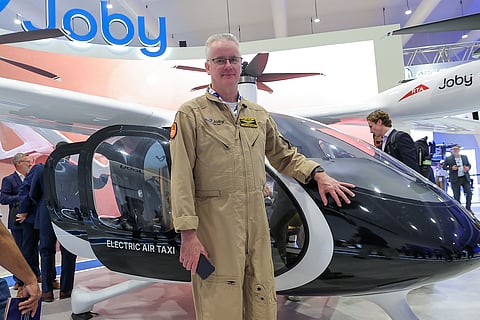How to become an air taxi pilot in the UAE: Joby test pilot reveals all
F-35 veteran reveals training path for aviation's newest profession in electric air taxis

Dubai: What does it take to become an air taxi pilot? As electric air taxis prepare to transform city skylines worldwide, a select group of test pilots are defining what it means to operate these revolutionary aircraft.
Among them is Peter "Wizzer" Wilson, a veteran aviator whose career has spanned Harrier jump jets, helicopters, and the cutting-edge F-35 fighter programme. Now, he's helping to shape the future as a test pilot for Joby Aviation, one of the world's leading electric air taxi developers.
What brings pilots home?
What draws experienced aviators to electric vertical take-off and landing (eVTOL) aircraft? For Wilson, the appeal is multifaceted and distinctly different from traditional aviation careers.
"I think it's something that you dream about," Wilson told Gulf News on the sidelines of the Dubai Airshow last week. "A lot of people will dream about the possibilities of taking to the air but also being able to come home to their houses at night."
The lifestyle contrast with conventional airline operations is stark. Airline pilots often spend extended periods away from home, with long-haul flights involving hours of cruise at altitude. Air taxi operations promise something entirely different.
"When you fly a Joby air taxi, you take off, and no sooner have you taken off, it's time to come in and land again," Wilson says. "So, it's up, and then hardly any cruise, and land. It's a very, very exciting prospect for young pilots."
From fighter jets to electric aviation
Wilson's transition to electric air taxis wasn't accidental. As his tenure with the F-35 programme approached its natural conclusion, he began searching for his next challenge—something that would keep him at the cutting edge of aviation technology.
"I wanted to find something else high tech, and I was very eager on being right at the cutting edge of technology," he said. "I was starting to look at the electric VTOL, because it was a very obvious progression for me to go from F-35 to this type of technology."
Fortune favoured him when friends who had begun their own research into the sector pointed him towards Joby Aviation. "They showed me the way, and I followed them, and I was very lucky," he says.
Simpler than you'd think
One might assume that piloting a revolutionary new aircraft would be extraordinarily complex. Wilson's experience suggests otherwise—at least compared to his previous rides.
"It's easier than flying an F-35 because in an F-35 you've got to put on the very big helmet and the oxygen mask and your life jacket and your G trousers, and you're strapped into an ejection seat," Wilson explains. "It's a little bit easier when you just have to get into a slightly smaller commercial vehicle."
His aviation background—from Harriers to helicopters to the F-35—prepared him well. "I've learned how to fly many different types of aircraft, and so when I jumped in this, it's very straightforward."
In fact, Wilson is confident about the aircraft's accessibility: "Anybody can learn to fly this aircraft. Anybody."
Two types of flying hours
Joby's approach to testing reveals the careful risk management inherent in developing new aviation technology. Wilson has accumulated approximately 200 hours of remote flying—operating the aircraft from the ground—and about 20 hours of inhabited flight.
"The remote flying is very useful because it de-risks us," he explains. "If the aircraft crashes, there's nobody on board, whereas once we're on board, the risk is very high. So, we tend to do a lot of our testing remotely."
This phased approach allows extensive testing whilst minimising risk to human pilots—a sensible strategy for any new aircraft programme.
The first flight
When Wilson finally took the controls for his first inhabited flight, the experience was profound.
"Excited, you know, humbled, surprised, gratified, pleased," he says, listing the emotions. "Oh, it's incredible. Yeah, to see it all come together."
Having flown the aircraft thousands of times in simulation, the real-world experience held both familiar and unexpected elements. "The real aircraft flies very similarly to the simulator, but then there's a few little things that are slightly different. The smell is different, the sounds are slightly different."
Contrary to expectations about "silent" electric flight, the aircraft does generate noticeable sound inside the cabin. "It makes a good amount of sound on the inside, and it's not loud, but it's not silent," Wilson said.
Also Read: Why Dubai is the birthplace of air taxis
How to become an air taxi pilot
For aspiring air taxi pilots, Wilson outlines a clear—if lengthy—pathway. The prerequisite remains a commercial pilot's certificate, the same qualification required for traditional commercial aviation.
"The cheapest way, if you want the quickest way, is to go fly an aeroplane, single engine," Wilson advises. "You're going to have to pay a couple of hundred US dollars for an hour. You're going to have to get many hours, about 500 hours, to get your commercial certificate."
Once that foundation is established, the transition to air taxi operations is surprisingly swift. "Then you come to Joby, learn how to fly the S4, and then you can fly the S4 for as long as you like."
The actual training time on the air taxi itself? Just 25 hours to achieve real proficiency. "Although, in reality, I could put you in the simulator right now, and within five minutes you could fly just fine," Wilson reveals.
Sign up for the Daily Briefing
Get the latest news and updates straight to your inbox





